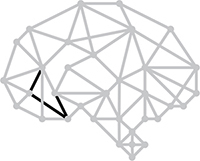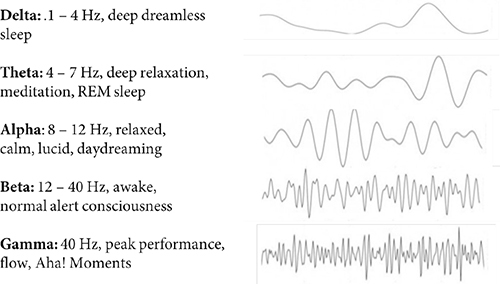CHAPTER 4
BRAINWAVES
“There exists a microscopic breed of brain beetle, commonly known as an ‘idea.’ An idea desires only one thing:
To catch the perfect brainwave.”
—Leah Broadby
T
HE ALARM WAKES JASON WITH
a start from an unsettled sleep. With a groan, he presses the snooze button.
He hates
mornings, especially Monday mornings.
Yesterday around four in the afternoon, like every other Sunday he can remember, his head started to ache and his gut tightened when the football game ended. The weekend had wound down, and another exhausting week was about to start all over again.
If Jason doesn’t get up immediately, he’ll miss the 5:40
AM
train and be late for work again—a bad habit the boss frequently reminds him about. He slides out of bed, showers, drinks two cups of strong coffee, and with the thrill and lightness of a garden slug, drags himself to the train station.
Like many of us, Jason has a bucket full of problems, and they’re getting worse. He’s deeply in debt and seems to get further in the hole every year. Occasionally, he’s given a small raise at work, but no matter how much money he makes, the government or the kids or his wife takes it. Or the house or the cars need repairs. Or the credit card companies want their cut.
Jason dreads going to work. He feels stuck in a dead-end job with no room for advancement and no recognition of his hard work, which has been slacking recently. The boss stifles his creativity, and his coworkers don’t seem to care that he’s too busy to give his full attention to group projects.
Jason’s personal life is a mess. He has no time for meaningful, relationship-building conversations or activities with his kids. They’re becoming increasingly distant and increasingly unavailable. He barely speaks to his wife because it takes too much energy to communicate, and he doesn’t know how to deal with disagreements. He and his wife usually end up yelling at each other and not solving anything.
What is going on with Jason?
THE MAGNIFICENT BRAIN
At the root of all our thoughts, emotions, and behaviors is the electrical and chemical communication that takes place in the neurons in our brains. There are approximately one hundred billion neurons and ten times as many glial cells in our brains.
Neurons
are cells that process and transmit information using electrical impulses. The electricity in your brain could power a twenty-watt bulb. These signals transition from one neuron to the other via specialized connections called synapses. Synapses, in turn, transmit information among the neurons with over one thousand unique proteins called neurotransmitters.
27
Through these synaptic connections, each neuron is linked to ten thousand other neurons. When our synapses are firing in harmony, they create a synchronized neural network linked to a specific state of consciousness, thought, and mood.

According to neuroscientist David Eagleman, “The cells are connected to one another in a network of such staggering complexity that it bankrupts human language and necessitates new strains of mathematics. A typical neuron makes about ten thousand connections to neighboring neurons. Given the billions of neurons, this means there are as many connections in a single cubic centimeter of brain tissue as there are stars in the Milky Way galaxy.”
28
Physicist Michio Kaku says the human brain “is the most complicated object in the known Universe.”
29
BRAINWAVES
The combination of synchronized electrical activity is called brainwave activity because of the wave-like patterns it creates as the brain does its work. These brainwaves can be detected and measured using an electroencephalogram (
EEG
), which measures wave levels throughout the brain. Neurologists have identified five types of brainwaves. From slowest to fastest, they are:
Delta:
Delta brainwaves have the slowest frequency, typically .1 to 4 cycles per second. When you’re in deep, dreamless sleep, your brain produces delta brainwaves.
Theta:
Theta brainwaves range from 4 to 7 cycles per second. When you’re sleeping and dreaming, your brain is producing theta brainwaves.
Alpha:
Alpha brainwaves are faster than theta, ranging from 8 to 12 cycles per second. When you have completed a task and sit down to rest, you are most likely in a daydreaming, alpha state. When you ponder, meditate, or take a leisurely stroll, you are usually in an alpha state.
Beta:
Beta brainwaves are faster than alpha, ranging from 12 to 40 cycles per second. When you are engaged in conscious mental activities, in conversation, or actively listening, beta waves dominate. Beta waves are characteristics of a strongly engaged mind.
Gamma:
Gamma brainwaves are the fastest brainwaves, moving at a rate of 40 to 90 cycles per second. Gamma brainwave production involves the entire brain, tends to be short-lived, and is associated with moments of increased awareness, heightened consciousness, and intellectual acuity. A gamma spike is a momentary production of gamma brainwaves that takes place shortly before you experience an Aha! Moment or a Big Idea.
Like Jason, most people experience all five types of brainwaves during a twenty-four-hour period. When we are awake, all five types of brainwaves might be active, but one brainwave state is dominant at any given time.
The brain works optimally by shifting from one dominant brainwave state to another every few hours. Even when we dream, our brains transition every ninety minutes or so, back and forth among alpha, the slower theta, and the even slower delta state. If we stay in one primary brain state for too long, we become exhausted, anxious, lethargic, or we simply fall asleep.



